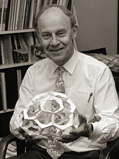Outdoing Maxwell’s Demon: Taming Molecular Wildness
Additional materials available (4)
Licensed under General Performance Usage.
Category
Published on
Abstract
Bio
 Third-generation native of San Jose, California. Grew up near Cupertino, in what was then rural area; for years milked cows, fed chickens and pigs, picked prunes, apricots, and walnuts in summers. First in his family to attend college, recruited as a football player. Earned B.S. in math and M.S. in chemistry at Stanford, mentored by George Polya and Harold Johnston; A.M. in physics and Ph.D. in chemical physics from Harvard, mentored by E. Bright Wilson. Appointed assistant professor of chemistry at U.C. Berkeley in 1959, undertook experiments to probe reaction dynamics of molecules in single collisions. Returned to Harvard in 1963. With Yuan Lee and John Polanyi, shared Nobel Prize in 1986. Taught graduate courses in quantum mechanics, molecular spectroscopy, and collision theory; undergrad courses in physical chemistry and for twenty years freshman chemistry.
Third-generation native of San Jose, California. Grew up near Cupertino, in what was then rural area; for years milked cows, fed chickens and pigs, picked prunes, apricots, and walnuts in summers. First in his family to attend college, recruited as a football player. Earned B.S. in math and M.S. in chemistry at Stanford, mentored by George Polya and Harold Johnston; A.M. in physics and Ph.D. in chemical physics from Harvard, mentored by E. Bright Wilson. Appointed assistant professor of chemistry at U.C. Berkeley in 1959, undertook experiments to probe reaction dynamics of molecules in single collisions. Returned to Harvard in 1963. With Yuan Lee and John Polanyi, shared Nobel Prize in 1986. Taught graduate courses in quantum mechanics, molecular spectroscopy, and collision theory; undergrad courses in physical chemistry and for twenty years freshman chemistry.
Emeritus at Harvard since 2002, have continued since to teach freshman seminar (“Molecular Motors: Wizards of the Nanoworld”) there; also have visiting appointments in physics and astronomy at Texas A & M University and at the geophysical laboratory at the Carnegie Institution of Washington. Current research topics: pursuing an unorthodox dimensional scaling approach to electronic structure; elucidating interaction of molecules with superintense laser fields; analysis of wave function entanglement that pertains to proposed quantum computers; experiments striving to produce very slow, cold molecular beams which act like waves.
Efforts to enhance science education and public understanding have centered for 20 years on the Society for Science and the Public, which publishes Science News and conducts the Intel Science Talent Search and the Intel International Science and Engineering Fair. Have had many radio and TV appearances, including as a guest voice on The Simpsons. Also a life member of Friends of Franklin and of the Sierra Club, and for many years chaired the Hans Bethe Center for Arms Control and Nonproliferation.
Sponsored by
Cite this work
Researchers should cite this work as follows:
Time
Location
WTHR 201, Purdue University, West Lafayette, IN